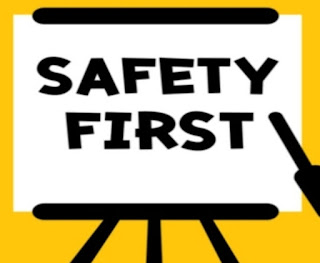Safety Interview Questions 3 contains following questions with answers.
21. What is near miss/ near hit/ close call/ dangerous occurrence?
22. What is hazard?
23. What is risk?
24. What is risk assessment?
25. How to assess risk?
26. What is job safety analysis (JSA)?
27. How to perform JSA?
28. How to prevent accident?
29. If there is an accident at site/ work place, what would you do?
30. What are Tool Box Talk / Pep talk?
21. What is near miss/ near hit/ close call/ dangerous occurrence?
An incident where no injury, ill-health or fatality occurs is called near miss/ near hit/ close call/ dangerous occurrence- OHSAS
22. What is hazard?
Hazard is a potential condition awaiting to be converted into an unwanted event or accident.
Or Anything with potential that cause harm is called hazard.
23. What is risk?
Combination of the likelihood of an occurrence of a hazardous event(s) or exposure(s) and the severity of an injury/ ill-health that can be caused by event(s) or exposure(s) is called risk- OSHAS
Or Risk is the product of two functions that is possibility of the accident which might occur and the severity of the event if it occurs.
24. What is risk assessment?
The process of evaluating the risk to health and safety arising from hazard at work is called risk assessment.
Risk assessment is an analysis of a hazard to assess the risk in terms of both severity and probability.
25. How to assess risk?
There are five steps in assessing the risk-
I. Identify the hazards
II. Identify the population at risk/ decide who
might be harmed & how
III. Evaluate the risk
Estimation of risk
Evaluation of risk
Existing control measures
IV. Record findings and implement them.
V. Review assessment and update if necessary.
26. What is job safety analysis (JSA)?
JSA is a procedure of analyzing the jobs for the specific purpose of finding the hazards in each step in the job and developing the safety precautions to be taken.
27. How to perform JSA?
There are four steps in performing JSA -
I. Select the job.
II. Break the job into successive steps.
III. Identify the hazards and potential accident.
IV. Develop ways to eliminate hazards and
potential accident.
28. How to prevent accident?
Hierarchy of control: - ERICPD
A. Elimination
B. Reduction/Substitution
C. Isolation
D. Control Measures-
Administrative Control
Engineering Control
E. PPEs
F. Discipline
IITS (Information, Instruction, Training &
Supervision)
29. If there is an accident at site/ work place, what would you do?
Provide first aid
Call for a doctor/ rush to the nearest hospital
Remove crowd and give condolence to the injured person
Inform to the senior/ site in charge
Barricade the accident spot
Make the area safe
Identify the witness
Form the accident investigation team
Investigate accident/ incident and report it to safety department (HO if reportable)
30. What are Tool Box Talk / Pep talk?
Tool Box Talk is a meeting taken by concerned foreman / supervisor with their team members for their respective job to identify and resolve Environmental, Health & Safety (EHS) Hazards associated with the specific task prior to perform.
Or
Before starting any work workers are given knowledge in group regarding safe practice by concerned Engineer/ supervisor/ foreman in the presence of safety professional is said to be Tool Box Talk/ Pep talk.
Note: - The Tool box Talk card must be signed off by all participants & displayed in the immediate work place.
PPEs (Personal Protective Equipments)
6 HTK (Hazards that kill)- height work, vehicles
movement, electricity, housekeeping, confined space,
hazardous chemicals
Topics of tool box talk/ pep talk
i. PPEs
ii. Housekeeping
iii. Body protection like- eyes, ears, hands, legs, lungs,
skin etc.
iv. Working at night
v. Working at height
vi. Causes of accident
vii. Unsafe acts/ practices
viii. Unsafe/ Substandard conditions
ix. Cost of accident
x. Hot works (Welding/ Grinding/ Gas cutting)
xi. Excavation
xii. Confined space
xiii. Mansion work
xiv. Carpentry work
xv. Civil work
xvi. Electrical work
xvii. Chemical work
xviii. Mechanical work
xix. Loading /unloading
xx. Mechanical handling
xxi. Manual handling
xxii. Crane/ JCB/ Hydra/ Rig/ Tower crane etc.
xxiii. Driving safety
xxiv. Health, Safety and Environment
xxv. Road crossing Etc

